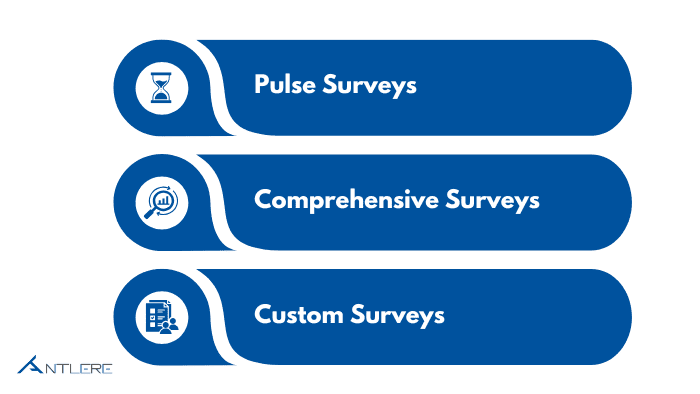

Employee Satisfaction Survey: Your Key to Workplace Happiness
In today’s fast-paced corporate world, companies can now see how satisfied employees can lead to a more successful business. Employee satisfaction survey is a powerful way of gauging this. As opposed to the traditional HR check ins, these tools provide practical insights that can radically improve the company’s culture, employee engagement and productivity.
Now let’s dig into what an employee satisfaction survey is, why it’s important, and how your organization can best use one.
What Is an Employee Satisfaction Survey?
An employee satisfaction survey is a crucial tool to help your organization identify problems to prevent your employees from leaving.
An employee satisfaction survey is essentially a structured questionnaire meant to collect employees’ feedback on different features of their work experience like job satisfaction, workplace environment, and managerial effectiveness. These surveys give companies an idea of how employees are feeling about their job, where they need to take measures to improve and help them to strategize ways to encourage a positive working environment.
Why It Matters
According to research, satisfied employees outperform their dissatisfied coworkers by 12% on the productivity front. In addition, according to the Gallup study, companies that have happy staff earn 21% more than the average! The correlation between satisfaction and performance means that an employee satisfaction survey is a need for today’s organizations looking to make it and stay in business.

Why Is an Employee Satisfaction Survey Important?
Enhancing Retention Rates
One of the biggest challenges businesses face today is high turnover. Regular employee satisfaction surveys conducted will help identify dissatisfaction early so that a proactive solution can be taken. For example, Google’s surveys examine employee flexibility and work life balance, which has led to a dramatic rise in their employee retention.
Boosting Productivity
A happy workforce makes for a productive workforce. Companies can therefore use surveys to get a better picture of bottlenecks, or areas of concern, and then make changes to the situation to increase overall efficiency. For example, employees at Netflix score highly when they are presented with autonomy in surveys that the company conducts regularly.
Building Trust and Transparency
When organizations seek feedback through employee satisfaction survey tools, it fosters trust. Employees feel heard, valued, and motivated to contribute more meaningfully. In turn, this creates a culture of transparency where feedback drives continuous improvement
What Are the Different Types of Employee Satisfaction Survey?
To reap the full benefits, organizations need to pick the right type of survey. Here are the most common ones:

Pulse Surveys
Pulse surveys are short and conducted frequently to give you real-time insights into employee sentiments. They are particularly useful for finding out how much of an impact policy changes have.
Comprehensive Surveys
These extensive surveys are filled out yearly or every two years and include subjects as wide as workplace satisfaction, management, and firm culture.
Custom Surveys
Customized to certain needs, custom surveys examine specific challenges or projects within the organization, from diversity and inclusion to employee well-being.
How to Design an Effective Employee Satisfaction Survey?
For your efforts to have impact, your surveys need to be actionable. Here are some key considerations:
Ask the Right Questions
The purpose of the survey should resonate in the questions you ask. For example, specific queries on the issue of workload, career development and workplace environment. Some common employee satisfaction survey questions include:
- To what extent, on a scale of 1 to 10, are you satisfied with your role now?
- Are you a person who feels appreciated and who their bosses recognize for what they do?
- Is there a good enough growth and advancement opportunity?
Leverage Technology
Employee satisfaction survey software makes the entire process smooth; it is simple to collect and analyze data. Customizable templates with real time analytics and actionable insights are provided by Antlere’s smart survey solutions.
Ensure Anonymity
A safer way to get honest feedback from employees is when they feel safe. Anonymity allows us to be honest and truthful in our data.
How to Implement Survey Results
Gathering data is only the first step. It is interpretation and acting on those findings that gives real value.
Analyze the Data
With advanced employee satisfaction survey tools, you can see trends and how things are being tracked as well as the strengths and areas where you can improve. In fact, let’s say poor communication was a concern raised by more than half of those working there, which means the company will need to improve its communication strategies inside.
Develop Action Plans
Utilizing survey results, targeted initiatives must be created. For example, if employees feel misunderstood regarding careers, create mentorship programmes or clear routes to promotion.
Communicate Back to Employees
Transparency is key. Publish the survey findings and steps which your organization has planned to take. For example, Microsoft publishes a summary of survey results, and keeps employees informed on the progress of related initiatives.

Company examples that lead with an employee satisfaction survey.
Google
Google enjoys a well-deserved reputation for its workplace culture and the sophisticated IT tools it uses to gather insights into everything from work life balance to diversity. Awards that placed them on the “Best Places to Work” lists have consistently arisen from their commitment to employee feedback.
HubSpot
Hubspot company has a great reputation of leveraging surveys to get an insight on how people feel about us as a company. They share the results with their employees often and build a culture of sharing and trust.
Salesforce
Instead, Salesforce’s survey for employee satisfaction is about employee well-being, resulting in initiatives such as mental health programs coming directly from survey insights.
Here’s what employee satisfaction surveys should track.
To measure success, organizations should monitor specific metrics:
- Net Promoter Score (NPS): How likely are employees here to recommend your company?
- Engagement Score: Determine how satisfied those in employees’ roles are with their engagement.
- Turnover Intent: Determine how likely it is they will leave in the next year.
Technology no longer has the option of being an add on. Employee satisfaction survey software has evolved to streamline this whole process.
Platforms like Antlere’s survey tool provide:
- Real-Time Analytics: The ability to quickly identify trends and patterns.
- Customizable Templates: Survey tailored to your organization’s needs.
- Automation: With automated distribution and follow-ups.
Final Thoughts
Surveys don’t have to be limited to clogging up an already busy inbox: they can be strategic assets guiding the future of your organization. Through an ongoing process of these surveys, using the best employee satisfaction survey tools, and responding to what we learn about, companies can help create a happier, more engaged workforce.
You must remember that for any employee satisfaction survey to be successful, it’s what gets done and is followed up on those matters.
Employee satisfaction is never easy, but it can be done with platforms like Antlere’s. Your people are your organization — invest in them, and your organization will thrive.

Frequently asked questions
How often should you conduct an employee satisfaction survey?
Employee satisfaction surveys should ideally be conducted at least once a year to get a thorough understanding of employee sentiment. However, pulse surveys can be conducted quarterly or even monthly to keep up with evolving workplace dynamics.
How does an employee satisfaction survey benefit small businesses?
Small businesses can use an employee satisfaction survey to identify problems like poor communication or lack of career development opportunities in a timely manner. These insights allow small businesses to implement cost-effective solutions to foster a positive work environment, improve retention, and compete with larger enterprises.
How long should an employee satisfaction survey be to ensure higher response rates?
Surveys should be concise, approximately 10-15 questions for general feedback. Lengthy surveys can lead to fatigue, so ensure questions are focused and relevant. Including a mix of multiple-choice, Likert-scale, and open-ended questions is recommended.
What is the best and most affordable employee satisfaction survey USA?
Antlere excels with real-time analytics, customizable templates, and automation for streamlined surveys. Its strong data security fosters trust, while a user-friendly interface ensures ease of use for businesses of all sizes. Antlere empowers organizations to boost engagement, build trust, and create thriving workplaces.



